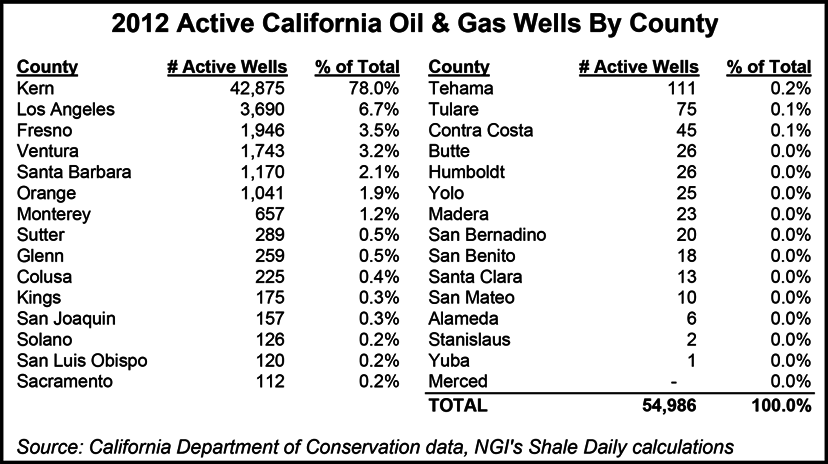California Gov. Signs Fracking Bill; Enviros Balk
Rejecting urgings from environmental groups to veto the bill, California Gov. Jerry Brown on Friday signed into law new regulations (SB 4) for hydraulic fracturing (fracking), but with the caveat that he intends to work on amendments next year to fine tune the requirements.

SB 4, which includes requirements that drillers disclose the chemicals used in the disputed drilling process, will be effective Jan. 1. Brown’s action was widely expected (see Shale Daily, Sept. 13).
Separately, Brown also signed a measure (SB 665) that strengthens the bonding requirements for oil and natural gas operators in the state to better ensure that drillers can pay for any environmental clean up related to their exploration and production (E&P) activities.
Brown directed the state Department of Conservation to “develop an efficient permitting program for well stimulation activities that groups permits together based on factors such as known geologic conditions and environmental impacts, while providing for more particularized review in other situations when necessary.” The department’s Division of Oil, Gas and Geothermal Resources is in the midst of developing detailed draft fracking rules (see Shale Daily, Sept. 9).
The governor also acknowledged that the new law “needs some clarifying amendments,” and he pledged to work with SB 4 author, state Sen. Fran Pavley, to make changes in the law.
Catherine Reheis-Boyd, president of the Western States Petroleum Association (WSPA), said there is “not a lot to like” about the new law, but praised the fact that it drew short of imposing a moratorium on fracking, which was advocated by environmental groups (see Shale Daily, Aug. 30).
“Energy production in California, already heavily regulated, will require more permits, more monitoring, more water testing, more disclosure and more notification of activities,” said Reheis-Boyd, while acknowledging that the law is “a framework for the future.”
She indicated that the state’s future should include “prudent and thoroughly regulated development of California’s energy resources.”
“While SB 4’s requirements went significantly farther than the petroleum industry felt was necessary, we now have an environmental platform on which California can look toward the opportunity to responsibly develop the enormous potential energy resource contained in the Monterey Shale formation,” Reheis-Boyd said.
In contrast, the California director of the Sierra Club, Kathryn Phillips, told local news media that she was disappointed by Brown’s signing of SB 4, arguing that the bill will not provide sufficient protection related to fracking that the public needs.
Pavley represents California’s 27th State Senate district, which includes portions of both Los Angeles and Ventura counties, two of the more active oil and gas drilling jurisdictions in the state (Los Angeles County had 3,690 active wells in 2012 and Ventura County had 1,743, according to NGI’s Shale Daily calculations). But those numbers were overshadowed by Kern County, where the vast majority of the state’s active oil and gas wells (42,875 wells, 78% of the state’s total) are located.
© 2024 Natural Gas Intelligence. All rights reserved.
ISSN © 2577-9877 | ISSN © 2158-8023 |

